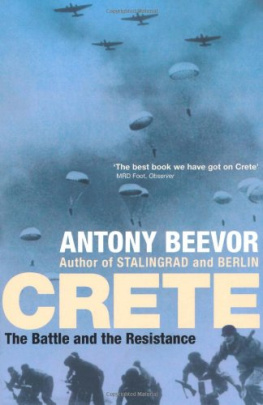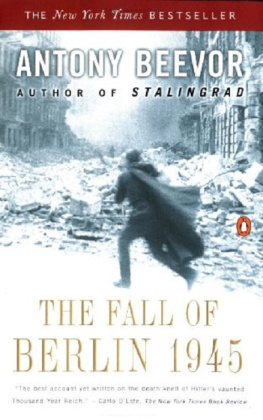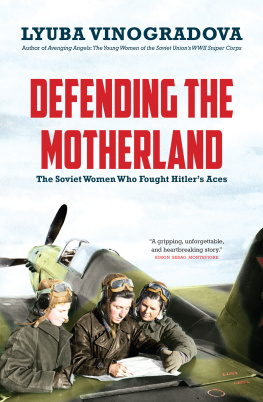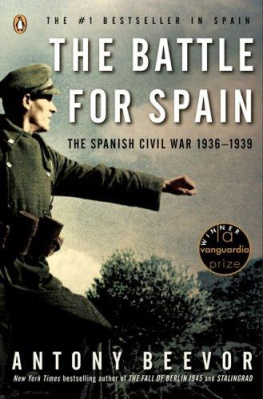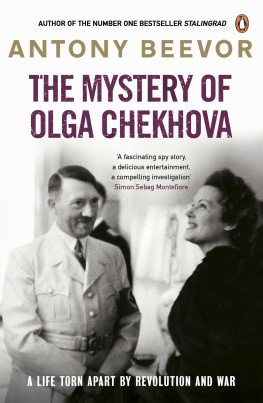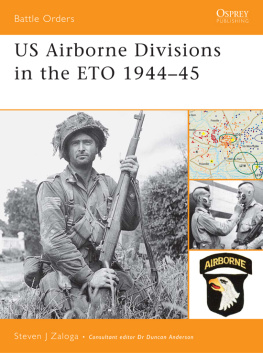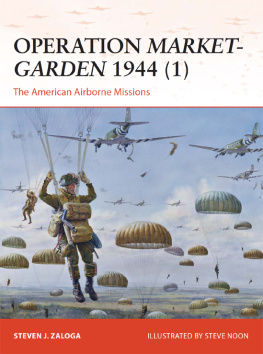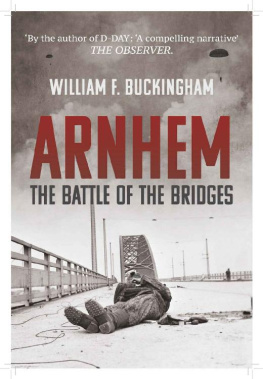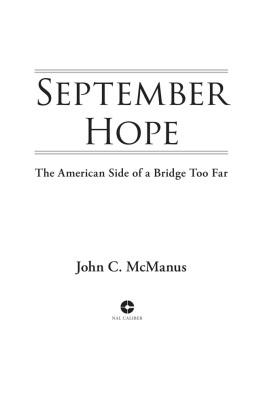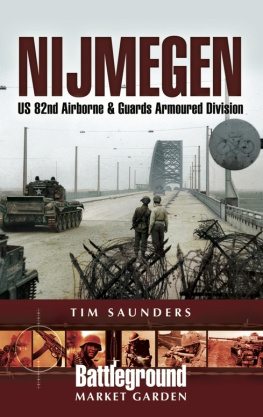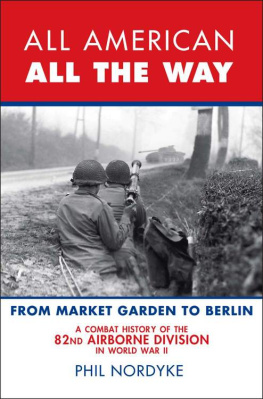
Antony Beevor
ARNHEM
The Battle for the Bridges, 1944

Contents
ARNHEM
Antony Beevor is the author of Crete: The Battle and the Resistance (Runciman Prize), Stalingrad (Samuel Johnson Prize, Wolfson Prize for History and Hawthornden Prize), Berlin The Downfall: 1945, The Battle for Spain (Premio La Vanguardia), D-Day The Battle for Normandy (Prix Henry Malherbe and the RUSI Westminster Medal), The Second World War and Ardennes 1944 (Prix Mdicis shortlist) . Acknowledged as the number one bestselling historian in Britain, Beevors books have appeared in thirty-two languages and have sold more than seven million copies. A former chairman of the Society of Authors, he has received a number of honorary doctorates. He is also a visiting professor at the University of Kent and an Honorary Fellow of Kings College London. He was knighted in 2017.
By the same author
Inside the British Army
Crete: The Battle and the Resistance
Paris after the Liberation ( with Artemis Cooper )
Stalingrad
Berlin: The Downfall 1945
The Mystery of Olga Chekhova
The Battle for Spain
D-Day
The Second World War
Ardennes 1944
For Artemis
List of Illustrations
. Admiral Sir Bertram Ramsay with Field Marshal Montgomery (IWM B 10113). The bridge at Arnhem over the Neder Rijn. A pre-war group of Dutch Nazis from the NSB. Teenage Waffen-SS recruits. Boy Browning with the Polish paratroop commander Major General Sosabowski. Viktor Grbner receiving the Knights Cross on 17 September. Sepp Krafft, the commander of the first SS troops to engage. The German command plans its response. Walter Harzer (9th SS Panzer-Division Hohenstaufen ). Horrocks, Montgomery and Prince Bernhard (IWM BU 766). Major General Maxwell Taylor, 101st Airborne. Brigadier General Jim Gavin, 82nd Airborne. The 21st Independent Parachute Company of pathfinders before boarding their Stirlings (IWM CL 1154). Gliders of the 1st Airborne (IWM CL 1146). The air armada over the Netherlands. Glider landing zone north-west of Arnhem, 17 September (IWM BU 1163). Brigadier General Anthony McAuliffe with officers of the 101st Airborne. 101st Airborne parachute drop north-west of Son, 17 September. British paratroopers having tea with locals (IWM BU 1150). A Sherman Firefly pushes past Irish Guards tanks (IWM BU 926). Another XXX Corps vehicle ambushed south of Valkenswaard (IWM B 10124A). The liberation carnival of shaving the heads of Dutch women who had slept with Germans. Proud members of the Dutch underground with weapons taken from the Germans. Crowds in Eindhoven on 19 September. British soldiers were amazed by the Dutch chalking messages of thanks. 101st Airborne welcomed between Son and St Oedenrode. German tanks for the Knaust Kampfgruppe arriving on a Blitztransport . Waffen-SS prisoners taken by the British 1st Airborne (IWM BU 1159). German artillery forcing a convoy to halt on Hells Highway. An RAF shot showing the wreckage of Grbners reconnaissance battalion (IWM MH 2061). Kate ter Horst, the Angel of Arnhem. Major General Roy Urquhart (IWM BU 1136). A Light Regiment 75mm pack howitzer east of the Bilderberg Hotel, 19 September (IWM BU 1094). One of the Luftwaffe ground crew in action north of Oosterbeek, 19 September. A Stug III of the 280th Assault Gun Brigade. SS panzergrenadiers in Arnhem amid abandoned British equipment. Civilians evacuated from the St Elisabeth Hospital. Polish paratroopers facing yet another cancellation due to bad weather. Sappers and 3rd Battalion Paras from the school north of the Arnhem bridge forced to surrender. Paratroopers from the 1st Battalion using a shell hole for defence (IWM BU 1167). C Company 1st Battalion of the Border Regiment on 21 September (IWM BU 1103). Luftwaffe anti-aircraft gunners of the Flak Brigade von Swoboda. Desperate paratroopers trying to signal to the RAF pilots (IWM BU 1119). A Waffen-SS half-track of the Hohenstaufen on the Dreijenseweg. American paratroopers under artillery fire. Walking wounded from Hotel Schoonord taken prisoner. Kampfgruppe Brinkmann prepares to cross to the south into the Betuwe. A mixture of Waffen-SS, German army soldiers and Luftwaffe in the Betuwe. On 24 September the Germans began the forced evacuation of Arnhem and the surrounding areas. Canadian troops finally liberate a deserted and ruined Arnhem (IWM BU 3510). A young victim of the Hunger Winter of 19445


List of Maps
Key to Military Symbols

Table of Military Ranks

This can only be an approximate guide to equivalent ranks since each army has its own variations. Some ranks have been omitted in the interests of simplicity. In the British and Canadian and US armies the following ranks command the following sub-units (below a battalion), units (battalion or regiment) and formations (brigade, division or corps).

A complete Order of Battle is available online at www.antonybeevor.com

The Chase is On!
Sunday 27 August 1944 was a day of perfect summer weather in Normandy. The soporific sounds of a cricket match could be heard from a field at Saint-Symphorien-les-Bruyres, south-west of Evreux. In the adjoining pear orchard, Sherman tanks of the Sherwood Rangers Yeomanry had just been refitted and repaired after the battle of the Falaise Gap, the culmination of the battle for Normandy. Bats, balls, pads and stumps had been smuggled ashore on one of their supply trucks. that we invaded the Continent unprepared, wrote one of the players.
The regiment was supposedly on twenty-four hours notice to move, but just after lunch the order came to move out in an hour. Its tanks were on the road in seventy minutes, heading for the River Seine, which the first British formation, the 43rd Wessex Division, had crossed at Vernon the day before. British troops were rather jealous that General George Pattons US Third Army had beaten them to a Seine crossing by six days.
On 29 August the Allied armies, now nearly a million strong, lunged forward from their bridgeheads east of the Seine, heading for Belgium and the German border. The battle for Normandy had finally been won, and the German army was in chaotic retreat. , an American officer wrote in his diary, you see the evidence of our air effort against the enemy. Trucks have been bombed and strafed, rusted and twisted in wild profusion along the roads, occasionally a truck load of gas cans with the cans bulging out like a swollen dead cow, black and charred, or a train with mounds of bulging cans, twisted steel frames from the destroyed box cars.
For British cavalry regiments, the chase was on. Lieutenant General Brian Horrocks, the commander of XXX Corps, mounted in the turret of a command tank, could not resist joining in. of warfare I thoroughly enjoyed, he wrote later. Who wouldnt? With more than 600 tanks Shermans, Churchills and Cromwells the Guards Armoured Division, the 11th Armoured Division and the 8th Armoured Brigade charged forward on a frontage of eighty kilometres, scything passages through the enemy rear areas, he added, like a combine-harvester going through a field of corn.
Next page

